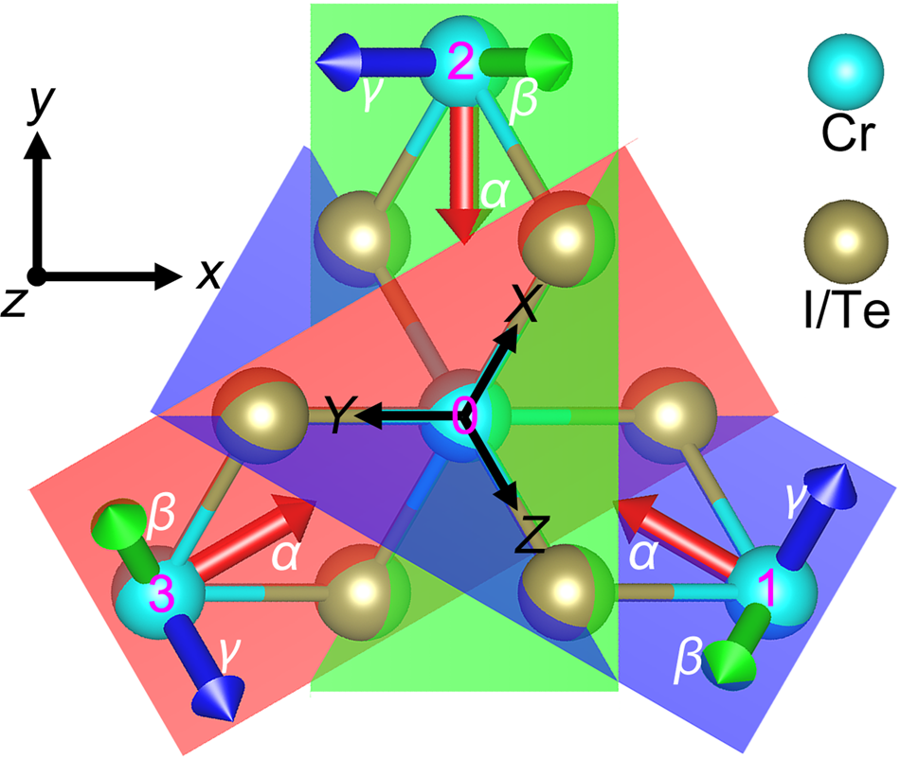Exploring Two-Dimensional Magnetism
Two-dimensional materials are made of single layers of atoms or molecules, and their unique properties are promising for many different applications. Until recently, however, scientists had been unable to identify any 2D materials that exhibit ferromagnetism, the strongest form of magnetism. In 2017, scientists discovered that two different materials — chromium iodide, (CrI3) and chromium germanium telluride (CrGeTe3) — are ferromagnetic. Now, researchers at the University of Arkansas have performed and analyzed calculations that lead to a better understanding of these materials. Their research could prove to be instrumental in the future development of quantum computing.
Magnetism is typically produced by the quantum spin of electrons. Electrons can be in either a spin up state or a spin down state, and electrons tend to pair up with their opposites and cancel each other out. However, if enough unpaired electrons in a material have the same spin, the material becomes ferromagnetic.
Although CrI3 and CrGeTe3 have similar structures, they are significantly different when it comes to the behavior of their spins. In CrI3, the spins of electrons lie up or down along a specific direction. This is called Ising behavior. In contrast, spins in CrGeTe3 exhibit what physicists call Heisenberg behavior, which means they can lie anywhere in the three-dimensional space. Imagine moving a pencil through the air: in the Ising model, you could point the pencil up or down, but in the Heisenberg model, you could also point it toward you or away from you, and you could point it left or right.
Until now, researchers have not been able to precisely explain why the electrons' spins in these two materials exhibit such different behaviors. A research team consisting of Changsong Xu, a postdoctoral fellow in the Department of Physics, and Laurent Bellaiche, Distinguished Professor of Physics, have performed and analyzed calculations that lead to a better understanding of these materials. The U of A researchers worked with Chinese colleagues at Fudan University, Hefei Normal University and the Collaborative Innovation Center of Advanced Microstructures. They published their results in the journal npj Computational Materials.
The researchers have developed a mathematical expression called a Hamiltonian to explore the nature of these materials. A Hamiltonian can be used to find the total energy of a system of particles.
"The Hamiltonian is the most important quantity for physics systems," explained Xu. "Once you have that, you can find all the properties. Our Hamiltonian is simple but powerful. Not only can it find the magnetic properties of these systems, but it can also be used on similar systems."
Using this Hamiltonian, the researchers found that these two materials exhibit something called the Kitaev interaction. This interaction is typically found in materials that have a honeycomb lattice shape, and, according to the researchers, the interplay between it and another property, single ion anisotropy, explains the different ferromagnetic behaviors of these two materials.
The presence of the Kitaev interaction is also significant because it is an important component of a theoretical type of matter called a quantum spin liquid. Quantum spin liquids, if they exist, would be a new phase of matter that could be used for quantum computing. The researchers plan to further investigate these materials to see if they could discover a quantum spin liquid.
This research was funded by the Office of Basic Energy Sciences of the Department of Energy and the Army Research Office, and was supported by the Arkansas High Performance Computing Center.
Contacts
Changsong Xu, post-doctoral researcher
Department of Physics
479-575-2506,
cx002@uark.edu
Camilla Shumaker, director of science and research communications
University Relations
479-575-5697,
camillas@uark.edu
Headlines
Four Students Named Goldwater Scholars; Two Earn Udall Honorable Mentions
Four U of A students have received the prestigious Goldwater Scholarship, an award for top students in mathematics, science, and engineering.
Cross-Campus Collaboration Culminates in New Outdoor Geological Installation
Grand opening event to celebrate the new GeoLab installation at the U of A’s Gearhart Hall courtyard is set for May 3. The installation will be open to the public year-round.
First Students to Use Online Degree to Hone Nursing Leadership, Elevate Patient Care
Hanna Baxendale and Wendi Kimbrell will begin coursework in the Doctor of Nursing Practice-Executive Master of Business Administration program offered by the Eleanor Mann School of Nursing and Walton College.
Join the Office for Sustainability on a Final Cruise to Campus
Cruise to Campus Wednesdays have fostered a gathering space for individuals interested in biking to campus. Drop by the Old Main Lawn from 7:30-10 a.m. Wednesday for coffee, something to eat and conversation.
Fay Jones School Student Ambassador Program Gives Voice to Design Students
The student ambassador program at the Fay Jones School of Architecture and Design is built to connect top design students with their school, its alumni, its future students and others inside and outside the school.





